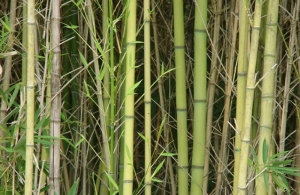
Description:
Bamboos are the fastest growing plants in the world. They are capable of growing up to 60 centimeters (24 in.) or more per day due to a unique rhizome-dependent system. However, this astounding growth rate is highly dependent on local soil and climatic conditions. Bamboos are of notable economic and cultural significance in East Asia and South East Asia where they are used extensively in everyday life as building materials, as a food source and as a highly versatile raw product.
Applications:
There are many applications possible for bamboo, such as culinary, medicine, construction, textile, and even musical instruments. If using bamboo for construction purposes it is critical to harvest the culms when at their greatest strength and when sugar levels in the sap are at their lowest, as high sugar content increases the ease and rate of pest infestation. Countertops, flooring, wall units, can be finished similar to an ordinary hardwood floor system.
Building with Bamboo:
Various structural shapes may be made by training the bamboo to assume them as it grows. Squared sections of bamboo are created by compressing the growing stalk within a square form. Arches may similarly be created by forcing the bamboo’s growth with the desired form and costs many times less than it would to assume the same shape in regular wood timber. More traditional forming methods such as the application of heat and pressure may also be used to curve or flatten the cut stalks.
Bamboo may also be cut and laminated into sheets and planks. This process involves cutting stalks into thin strips, planting them flat, boiling and drying the strips which are then glued, pressed and finished. Generally long practiced in China and Japan, entrepreneurs started developing and selling laminated bamboo flooring in the West during the mid 1990s; products made from bamboo laminate including flooring, cabinetry, furniture and even decorative use are currently surging in popularity, transitioning from the boutique market to mainstream providers such as Home Depot. The bamboo goods industry (which also includes small goods, fabric, etc) is expected to be worth $25 billion by the year 2012. The quality of bamboo laminate varies between manufacturers and the maturity of the plant from which it was harvested (6 years being considered the optimum); the sturdiest products fulfill their claims of being up to three times harder than oak hardwood but others may be softer than standard hardwood.
Availability:
Bamboo is the fastest-growing plant on Earth; it has been measured surging skyward as fast as 121 cm (48 in) in a 24-hour period,[6] and can also reach maximal growth rate exceeding one meter (39 inches) per hour for short periods of time. Many prehistoric bamboos exceeded heights of 75 meters (250 ft). Primarily growing in regions of warmer climates during the Cretaceous period, vast fields existed in what is now Asia.
Unlike trees, all bamboo has the potential to grow to full height and girth in a single growing season of 3–4 months. During this first season, the clump of young shoots grow vertically, with no branching. In the next year, the pulpy wall of each culm slowly dries and hardens. The culm begins to sprout branches and leaves from each node. During the third year, the culm further hardens. The shoot is now considered a fully mature culm. Over the next 2–5 years (depending on species), fungus and mould begin to form on the outside of the culm, which eventually penetrate and overcome the culm. Around 5 – 8 years later (species and climate dependent), the fungal and mold growth cause the culm to collapse and decay. This brief life means culms are ready for harvest and suitable for use in construction within 3 – 7 years.
Environmental Impact:
The bamboo species most often used to make flooring (Phyllostachys pubescens—known as “moso” in Japan, and “mao zhu” in China) matures in three years; is self-regenerating; and uses little or no fertilizers and pesticides. Chemical use is more common on plantations where edible shoots are grown. Carbon emissions and pollution from transportation involved in importing bamboo products is an environmental downside. However, the ocean freighters used for importing from China are relatively efficient at transporting goods compared with the trucks typically used for transporting domestic goods. The transportation energy of a Chinese bamboo flooring product may be comparable to a domestic hardwood flooring product.
Filed under: Materials, Bamboo, natural, Recycled

